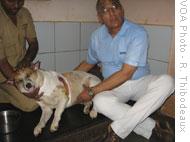voa标准英语2008-Mumbai's Animals Among Victims Caught in Crossfi(在线收听)
 |
| Indian police officers run to a new position around the landmark Taj Mahal hotel in Mumbai, India, 29 Nov 2008 |
Many of Mumbai's stray dogs are brought to a kennel, at the city's Bai Sakarbai Dinshaw animal hospital, a charity hospital mainly for stray animals wounded by street fights with other dogs or hit by cars.
But, on the first night of the terror attack, one of the dogs shot by the attackers was brought there. It was a stray dog hit by a stray bullet as gunmen battled with police at the city's main railway station. As bystanders rushed in to carry out the dead and the wounded people, a local newspaper photographer, 28-year-old Shripat Naik, spotted the dog in the station's foyer, bleeding, dazed and shaking.
"Everybody was frightened by that time, so nobody was going to help him," he said. "Everyone was frightened. They just told me that he was long dead so why bother. So I just took him along with me and admitted him into the hospital."
 |
| Sheru, a dog wounded by a stray bullet at Mumbai's main railway station, is attended by Dr. J.C. Khanna, head veterinarian at central Mumbia’s charity animal hospital |
Hospital workers here have named the beige-colored pooch "Sheru," Hindi for Lion-Heart. For them, Sheru has become a symbol of hope in this tragedy. His prognosis? He is expected to recover, the bullet having passed through his shoulder.
That is according to the hospital's lead veterinarian, Dr. J.C. Khanna, a retired lieutenant colonel in the Indian army.
Millions of stray animals, especially dogs and cats, but also cows, roam the streets of Mumbai, almost seamlessly woven into fabric of urban life in India.
Dr. Khanna says it is not surprising that some of these animals were killed, wounded and traumatized during the three-day siege in Mumbai, as the gunman rampaged through the city, spraying machine-gun fire and hurling grenades.
"You see, everyone is crying and worried for the human being, human life," said Dr. Khanna. "Nobody has yet thought about the animals, how much they have undergone trauma, physical and psychological.
In the assault, three trained rescue dogs were killed. The city's police and fire departments gave them funeral honors.
Of the hundreds of pigeons that have become scenic fixture in the square between the Gateway of India and the Taj Hotel, where the gunmen made their last stand, Dr. Khanna says at least 25 were killed and dozens more wounded as stray bullets, bomb blasts, shrapnel and thick black smoke filled the air. He says rescuers tried to save a fruit bat wounded in the attack.
"Ultimately, it is an ecosystem," said Dr. Khanna. "Everyone is connected to each other. If animals are not there, we are not there. So one must care for living creatures whether it is an animal or a human being."
By the end of the siege, the pigeons at the Taj had all but disappeared, adding to the anguish of many who saw them as a blessing. In India, pigeons are symbol of peace. Within three days after the attack ended, they had returned. That, along with Sheru's recovery, are hopeful signs for many here that Mumbai is returning to normal.